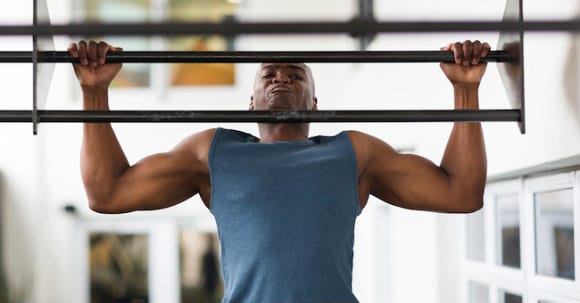By healthiergang writer , student in Medicine and Surgery.
Pull-ups At Home
The pull-up exercise is definitely a must for back training. One of the pivotal exercises to increase strength and power of the posterior muscles, especially involving the large Latissimus Dorsi (Great Dorsal) one of the largest and most powerful muscles in the body.
It is practically inevitable in any Functional Training session and, in its many variations, in Calisthenics. In the gym it is often replaced by the use of the Lat Machine, which in practice simulates the biomechanics of the exercise but denaturalizes the beauty of the pulling movement.
A little different speech for those who decide to train at home, where the alternatives seem few, unless you try your best. Let's see now with this article how to perform the pull-up exercise at home
1. Door bar
Many (including myself) have begun the approach to tractions by hanging and pulling themselves to the most disparate places, from the shelves hanging around the house to the frame of the bunk bed: sudden falls and blows are the order of the day. Not to mention the pieces of plaster that are sown around the house! The cheapest solution is certainly the door bar.
They have designed different versions with the possibility of carrying out the exercise using more than one handle, being able to carry out the exercise in prone, supine and neutral grip.
These are bars with which you can start learning the exercise, when the number of pull-ups is still low, without excessively overloading the door posts.
The user's weight range is up to 100-110kg maximum, making it suitable for most people.
Considering their particular formation, during the pulling exercise they should guarantee the greatest stability, given the particular play of the pins, but in any case it is necessary to have the right door, that is with a rectangular frame and with a certain width and not swing excessively, which could bring the upper pin to slide out of the door itself.
Another drawback are the scratches and abrasions to the fixtures that assembly and disassembly could cause. So it remains the ideal solution if we think of a subject that is not very heavy and performs a low number of repetitions.
2. Door entry bar
The next step is the door bar, more solid than the previous one as it additionally provides for the fixing to the skeleton of the door with screws or with an interlocking fixing mechanism.

Here too, however, as in the previous case, the pros certainly concern the price and transport, since they are very cheap and can be transported wherever you want; given the possibility of adjusting its length, it is adaptable to many types of doors.
The cons always concern the maximum weight of the athlete, similar to the previous ones, and having to control the movement both in the ascent and descent phase, being careful not to swing excessively.
3. Power Tower
For those who have a larger budget to be able to invest in pull-ups at home, the choice can fall on two types of tools: bars with wall mounting or Power Tower.
This latter is the ideal solution not only for those looking for a valid tool to perform pull-ups, but also for those who want to perform other types of exercises, such as parallel dips or reverse crunches (where the torso does not bend towards the legs. , but it is the lower limbs that are brought to the torso with an abdominal flexion movement).

They are very stable structures, usually built in steel, with the possibility of having different handles available here too (depending on the Tower model) with which to perform variations of the exercise. They are also structures that can be closed. Therefore, they are not bulky both in width and in length, while you need to have a space in height of at least 2-2,5 meters to perform the tractions without banging your head.
Also in this case it is preferable to limit the fluctuations. Therefore, I do not recommend kipping and butterfly pull-ups because the tool could destabilize. In this case the weight limit can be an issue, with most models supporting a user of 100-120kg maximum.
Wall-mounted bars, on the other hand, have hardly any weaknesses. If built in iron or steel these are practically indestructible. The declared weight limits for the vast majority of models is 300 and passes kilograms. The fluctuations are not a problem; you just have to make sure you have the right type of wall or get the right equipment.
For reinforced concrete walls, 13 or 15 fishermen are enough while for old houses with tuff bricks the smartest and safest solution is to drill the entire thickness of the wall using threaded bars and plates that distribute the weight over the entire wall.
I have adopted the latter solution and I have not encountered any kind of problem even in carrying out the kipping, which involve large oscillations.
Conclusion
All the solutions proposed so far for home pull-ups have a single drawback if we can say so: they involve the purchase of a tool.
There are those who prefer to use everything they have at home to train.
The Doctor and Coach proposed a solution that is as easy as it is ingenious. That is, use an aluminum or iron home ladder to be used as a support and a metal rod for grip. It's a smart, no-cost solution to working out at home by incorporating exercise into a home routine.


























